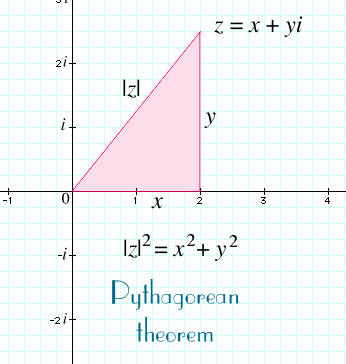
For a complex number z = x + yi, we define the absolute value |z| as being the distance from z to 0 in the complex plane C. This will extend the definition of absolute value for real numbers, since the absolute value |x| of a real number x can be interpreted as the distance from x to 0 on the real number line.
 We can find the distance |z| by using the Pythagorean theorem. Consider the right triangle with one vertex at 0, another at z and the third at x on the real axis directly below z (or above z if z happens to be below the real axis). The horizontal side of the triangle has length |x|, the vertical side has length |y|, and the diagonal side has length |z|. Therefore,
We can find the distance |z| by using the Pythagorean theorem. Consider the right triangle with one vertex at 0, another at z and the third at x on the real axis directly below z (or above z if z happens to be below the real axis). The horizontal side of the triangle has length |x|, the vertical side has length |y|, and the diagonal side has length |z|. Therefore,
(Note that for real numbers like x, we can drop absolute value when squaring, since |x|2 = x2.) That gives us a formula for |z|, namely,
The unit circle. Some complex numbers have absolute value 1. Of course, 1 is the absolute value of both 1 and –1, but it's also the absolute value of both i and –i since they're both one unit away from 0 on the imaginary axis. The unit circle is the circle of radius 1 centered at 0. It include all complex numbers of absolute value 1, so it has the equation |z| = 1.

A complex number z = x + yi will lie on the unit circle when x2 + y2 = 1. Some examples, besides 1, –1, i, and –1 are ±√2/2 ± i√2/2, where the pluses and minuses can be taken in any order. They are the four points at the intersections of the diagonal lines y = x and y = x with the unit circle. We'll see them later as square roots of i and –i.
You can find other complex numbers on the unit circle from Pythagorean triples. A Pythagorean triple consists of three whole numbers a, b, and c such that a2 + b2 = c2 If you divide this equation by c2, then you find that (a/c)2 + (b/c)2 = 1. That means that a/c + i b/c is a complex number that lies on the unit circle. The best known Pythagorean triple is 3:4:5. That triple gives us the complex number 3/5 + i 4/5 on the unit circle. Some other Pythagorean triples are 5:12:13, 15:8:17, 7:24:25, 21:20:29, 9:40:41, 35:12:27, and 11:60:61. As you might expect, there are infinitely many of them.
The triangle inequality. There's an important property of complex numbers relating addition to absolute value called the triangle inequality. If z and w are any two complex numbers, then
 You can see this from the parallelogram rule for addition. Consider the triangle whose vertices are 0, z, and z + w.
One side of the triangle, the one from 0 to z + w has length |z + w|. A second side of the triangle, the one from 0 to z, has length |z|. And the third side of the triangle, the one from z to z + w, is parallel and equal to the line from 0 to w, and therefore has length |w|. Now, in any triangle, any one side is less than or equal to the sum of the other two sides, and, therefore, we have the triangle inequality displayed above.
You can see this from the parallelogram rule for addition. Consider the triangle whose vertices are 0, z, and z + w.
One side of the triangle, the one from 0 to z + w has length |z + w|. A second side of the triangle, the one from 0 to z, has length |z|. And the third side of the triangle, the one from z to z + w, is parallel and equal to the line from 0 to w, and therefore has length |w|. Now, in any triangle, any one side is less than or equal to the sum of the other two sides, and, therefore, we have the triangle inequality displayed above.
Next section: Multiplication
Previous section: The complex plane, addition and subtraction
 © 1999.
© 1999.
David E. Joyce
Department of Mathematics and Computer Science
Clark University
Worcester, MA 01610
Email: djoyce@clarku.edu
These pages are located at http://aleph0.clarku.edu/~djoyce/complex/